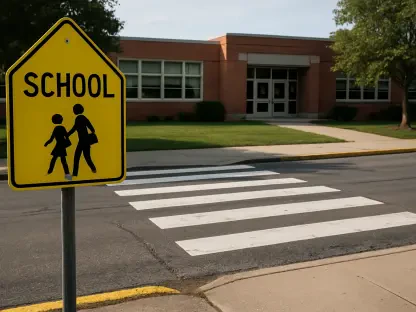Across the United States, a growing wave of concern over student mental health and academic distractions has prompted an unprecedented push to limit cellphone use in schools, with 35 states now enforcing some form of restriction. This surge in policy changes reflects a bipartisan acknowledgment that smartphones may play a significant role in exacerbating anxiety, depression, and disengagement among students. As educators and policymakers grapple with balancing technology’s benefits against its potential harms, stories from classrooms reveal a stark reality: students are both struggling to adapt and experiencing newfound focus. The debate extends beyond school walls, involving parents worried about safety and researchers seeking definitive answers on long-term impacts. This movement, driven by a desire to prioritize well-being and learning, raises critical questions about how to implement effective restrictions without alienating key stakeholders or overlooking individual needs.
A Nationwide Push for Restrictions
The rapid adoption of cellphone bans in schools marks a significant shift in educational policy, with 17 states and the District of Columbia introducing new rules during the current academic year. States like Kentucky, Florida, and Georgia have taken the lead, implementing a range of measures from complete daily prohibitions to targeted restrictions based on grade levels. These policies stem from mounting evidence linking excessive smartphone use to mental health challenges and diminished academic focus. Students in affected schools, such as those in Louisville, have reported tangible benefits, including more attentive teachers and fewer distractions during lessons. Educators echo this sentiment, noting a marked reduction in classroom disruptions. This widespread momentum suggests a growing consensus that limiting screen time can foster a healthier learning environment, though the specifics of enforcement vary widely across regions, reflecting diverse local priorities and challenges.
Beyond the immediate classroom effects, the push for bans highlights a broader societal concern about the role of technology in young lives. While the primary goal is to curb distractions and support mental well-being, early feedback from schools indicates an additional upside: enhanced student interaction. Where phones once dominated breaks and downtime, face-to-face conversations are making a comeback, potentially strengthening social bonds. However, the transition has not been seamless. Adjusting to new routines, such as storing devices in lockers or specialized pouches, has met with initial pushback from students accustomed to constant connectivity. This adaptation period underscores the need for clear communication and support systems to ensure policies are not only enforced but also understood as beneficial. As more states consider similar measures, the lessons learned from early adopters will likely shape future approaches to balancing technology and education.
Mixed Reactions from Students and Parents
The implementation of cellphone bans has elicited a spectrum of responses from students, revealing a complex interplay of benefits and frustrations. Some, particularly in high schools across Atlanta, appreciate the reduction in distractions, noting that lessons feel more engaging without the constant lure of notifications. Yet, others express discontent over losing access to tools like music apps, which they claim help with concentration during independent study. This dichotomy highlights a critical challenge: while the intent behind bans is to improve focus, not all students perceive the absence of their devices as positive. Schools are thus tasked with addressing these varied needs, ensuring that policies do not inadvertently hinder learning styles that rely on technology. The student perspective remains a vital consideration as administrators refine their approaches to enforcement.
Parental reactions add another layer of complexity to the unfolding narrative around cellphone restrictions. Safety concerns dominate discussions, with many parents uneasy about losing direct communication with their children during the school day. In an era marked by heightened awareness of school violence, the ability to reach a child instantly often feels non-negotiable. This anxiety is compounded by past experiences of delayed notifications during emergencies, leaving families skeptical of school assurances. Research from academic institutions points to parental resistance as a significant hurdle, with calls for greater involvement in policy development gaining traction. Advocacy groups emphasize the importance of striking a balance between educational goals and security needs, urging districts to incorporate family input. As these bans proliferate, addressing parental apprehensions will be crucial to building trust and ensuring widespread acceptance.
Research and Resistance Shape the Debate
Academic and research communities are deeply engaged in examining the impact of smartphones on student mental health, though definitive conclusions remain elusive. Studies have identified a correlation between heavy social media use and declining well-being, yet establishing causation is far from settled. Experts caution against blanket assumptions, pointing to the dual nature of technology as both a potential harm and a valuable resource. Preliminary data from schools with active bans shows encouraging signs, such as fewer disciplinary incidents and improved engagement during class time. However, the long-term effects on academic outcomes and emotional health are still under scrutiny. This ongoing uncertainty suggests that policies must remain flexible, allowing for adjustments as new evidence emerges. Tailoring restrictions to address specific risks while preserving beneficial uses of technology is a delicate but necessary endeavor.
Not every state has embraced the trend toward stringent cellphone bans, revealing a fragmented landscape of opinions and approaches. In places like Wyoming and Michigan, proposals for statewide restrictions have been met with rejection, often due to arguments favoring local control and parental discretion. Critics of broad mandates contend that individual districts are better equipped to understand and address their unique challenges, rather than adhering to a one-size-fits-all policy. This resistance underscores a broader tension in the national conversation about how best to integrate technology into education without compromising safety or autonomy. As the debate evolves, it becomes clear that achieving consensus will require nuanced dialogue among policymakers, educators, and communities. The diversity of perspectives ensures that solutions will need to be as varied as the concerns they aim to address.
Looking Back to Move Forward
Reflecting on the journey of cellphone bans in schools, it becomes evident that the drive to protect student mental health and academic focus has reshaped educational landscapes across numerous states. The swift policy changes tackled real challenges, from classroom distractions to social media’s potential toll on well-being, and yielded early signs of success in fostering engagement. Yet, the path was fraught with hurdles, as students adapted unevenly, and parents voiced valid safety fears. Research, while promising, left gaps that demanded ongoing exploration. Moving ahead, schools are encouraged to refine these policies with input from all stakeholders, ensuring restrictions support diverse learning needs. Collaborative efforts to design safety protocols alongside bans could ease family concerns, while pilot programs might test innovative balances between tech access and limits. The lessons drawn from these initial steps pave the way for smarter, more inclusive strategies in nurturing student growth.









